Challenge 5: Data-driven water security and safety
Data-Driven Water Management: Unlocking Insights with Emerging Technologies
The future depends on what we do in the present. – Mahatma Gandhi
Background
Supporting 16% of the world’s inhabitants is daunting enough, but it is even more so when recognizing that the population is crammed into an area one-third the size of the United States. Then consider that India only possesses 4% of the world’s fresh water and nearly 70% of it is contaminated, and the crisis can be more fully realized.
India may not be the only country facing this problem. However, theirs is at a more advanced stage, considering they face nearly 200,000 deaths per year due to the water crisis issue.
Challenges faced by the community
- Increased pollution of water bodies due to urbanization and industrialization
- Lack of water management systems and proper water infrastructure
- Excessive groundwater extraction
- Inadequate water distribution
- Leaky water supply networks
- Insufficient wastewater treatment facilities
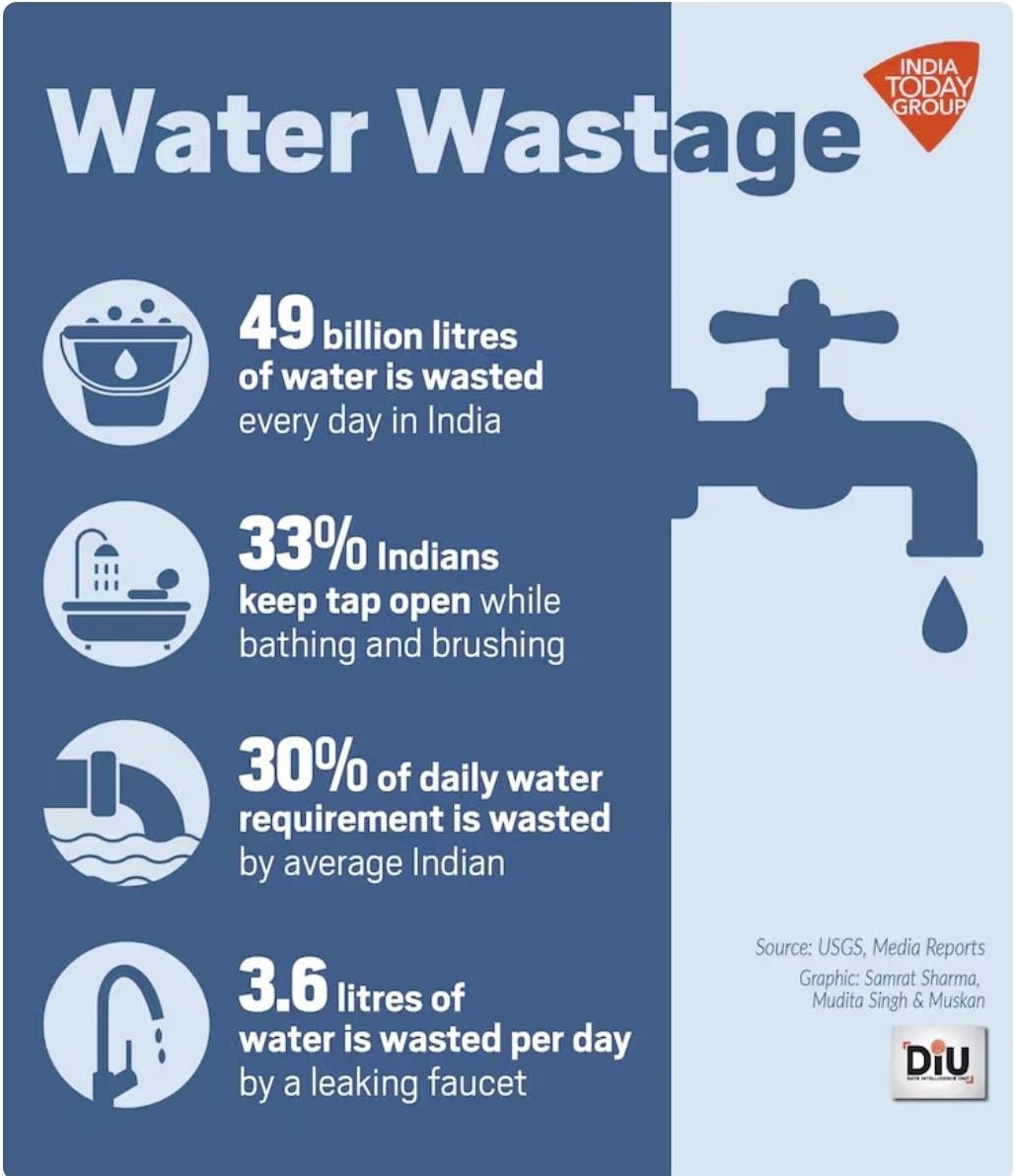
A 1983 study by Raman in nine cities found that a significant portion of water, ranging from 20-35% of the total supply, is lost due to leaks in mains, pipes, and valves. This translates to a substantial 40-85 litres per person per day, considering the average per capita water supply in Indian cities is between 100-200 litres daily. This is approximately 40% of the 900 million litres of water pumped daily from the Cauvery River. More recently, research conducted in Bangalore in 2019 revealed that around 360 million litres of water go to waste every day due to leakage and other reasons. These leaks not only waste precious water but also compromise its quality, potentially leading to the spread of waterborne diseases like typhoid fever, hepatitis A, and gastroenteritis due to aesthetic and microbiological contamination.
Project outline
The project outline has been deconstructed and reorganized to identify stakeholders, keywords, the initial How Might We Statement, the various user needs and challenges, potential directions, desired outcomes, reasons why this project is happening now, and the possible constraints presented by the challenge partner. We did this to approach our assigned wicked problem with a clear overview of our stakeholders, our users’ needs and challenges, and the potential constraints, as well as to identify our project’s various directions.

The solution
In India, the frequent occurrence of water pipe leaks has led to a sense of apathy among the public when it comes to reporting these issues. Over time, many citizens have become disillusioned by the slow response from authorities, who often take a considerable amount of time to address and repair reported leaks. This delay in action has dampened the initial enthusiasm that people once had for reporting such problems. As a result, when a new leak is observed, individuals are more likely to ignore it or hope that someone else will report it rather than take the initiative themselves due to a growing belief that their efforts may not lead to a timely resolution.
Our solution to the problem is designing an application for reporting water issues in households and in public. The application is mainly reliant on the community for data collection. They are responsible for reporting water issues, including leakages in the piping system, taps, or valves, illegal connections and tampering with meters, poor water quality, pipe bursts, and low water pressure.
Our solution, DripDetect, is made for residents, institutions monitoring water and sanitation, and plumbing businesses.
App flow for standard users
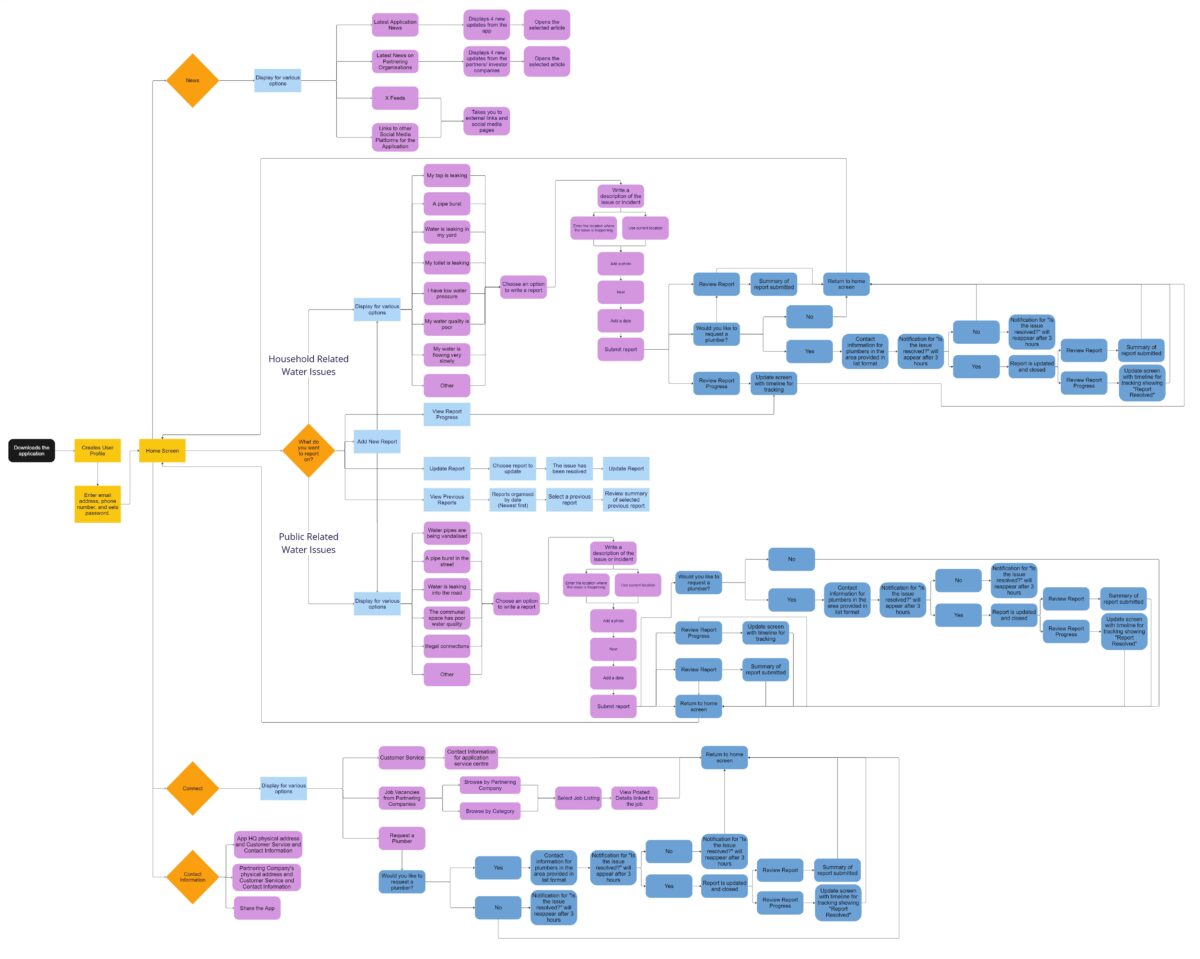
We have developed a general framework and flow of the application to display the various functionalities and options available to users. Whether it is getting updates on water-related news, reporting water-related issues, notifications for report updates, resolving a report, or contacting partnering companies.
The app has four main screens: News, What do you want to report on, Connect, and Contact Information.
The News section provides articles on the latest application news, the latest news from partner organizations, and social media platforms related to the application. In the section, Latest Application News, four articles about app updates, awareness campaigns, and water goals can be found to inform the user of how the app is being improved upon, which water awareness campaigns the app supports, and how water-related goals are being implemented and worked towards. The section, Latest News from Partnering Organisations, will feature articles discussing their achievements, news, and updates.
The What do you want to report on section allows for reporting water issues in public and residential areas. The application can request a plumber and send follow-up notifications for standard users after a plumber is asked for. The user will also be notified when their report has been resolved, or a municipal plumber has been sent. When the user submits a report, they can write a detailed description of the issue, take a photo, and choose the location where it is happening. After filling in the report, they add a date of when the issue took place and submit the report. They can then review the report, request a plumber, and view its progress. If a plumber for a specific location in a public area is asked for more than once, the users will be notified that a plumber has already been requested. Additionally, users can view their previous reports and track the progress of current and unresolved reports.
Under the Connect section, the user will find the app customer service information and job vacancies from partnering companies and can directly request a plumber. Job vacancies can be organized by either the company or by the category.
The Contact Information section lists the physical addresses and contact details of the application headquarters and partnering companies and provides the option to share the application.
App flow for professional users
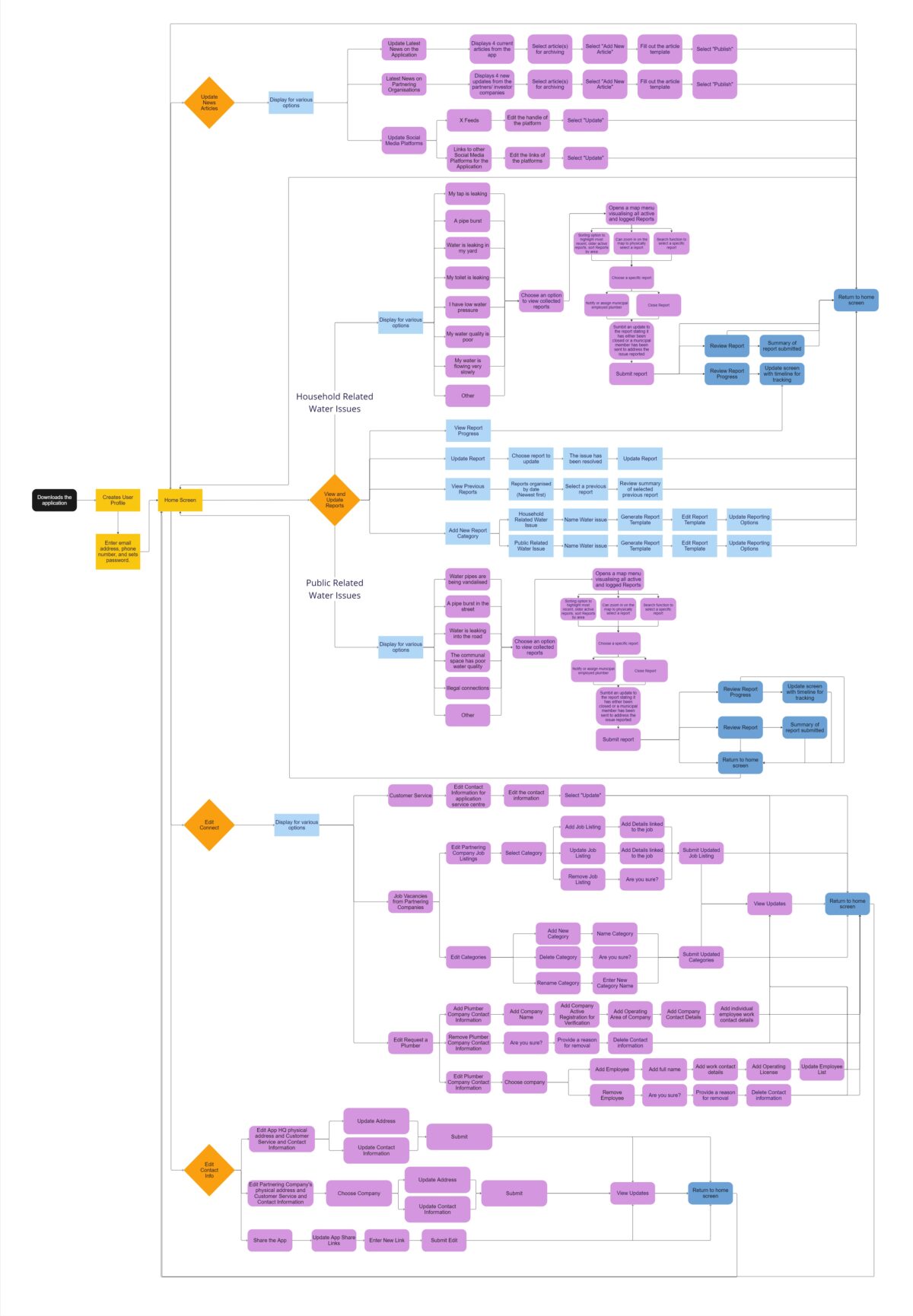
We have developed a general framework for the professional side of the application. This framework shows the functionalities that correspond with the standard application framework.
The application for professional users can be set to work for roles such as administrative, data analysis, and responding to and updating reports. Administrative roles include editing and updating the necessary content available on the application, such as the articles under the News section or the various types of contact information of the partnering and plumbing companies using the application. This role includes expanding the report categories. If a specific keyword or issue is reported extensively, it can be added as a new category to make reporting easier.
For data analysis-orientated roles, the application will form a starting point for a digital dashboard that uses GIS and remote sensing functionalities. Currently, the application will collect, organize, and display the data type selected on a map of India. Report categories will have corresponding color codes, leading to the possibility of individual issues being viewed as part of a systemic problem. This functionality will later be developed to help pinpoint and identify future system weaknesses or issues.
Responding and updating reports can form a part of the administrative tasks; however, for quicker updates, the employees of plumbing companies that subscribe to the application will be able to update and close reports as they address them. This allows for the responsibility of closing the reports to be shared by both the professional user and the standard user.
Reviewing Data and Detecting Future Leaks
The long-term plan is to build a dashboard with GIS and Remote sensing functionality for data analysis and advanced data collection. The Drip Detect mobile application can be enhanced with a GIS extension, which works similarly to GIS Cloud, to collect, store, and share details about the leak. The GIS functionality allows the user to pinpoint where the leak occurred. In the long run, the results can show common factors between the different leak occurrences, thereby revealing a pattern that could make predicting future leaks possible. The advantage of this is the early detection of defects in the underground piping system, which makes it easier to fix the problem before further damage to the infrastructure. In due time, satellite imagery can be leveraged to detect underground leaks and non-revenue water early. Integrating satellite systems will tackle the issues of slow reporting from community members and underground leaks that may not yet be visible on the surface.
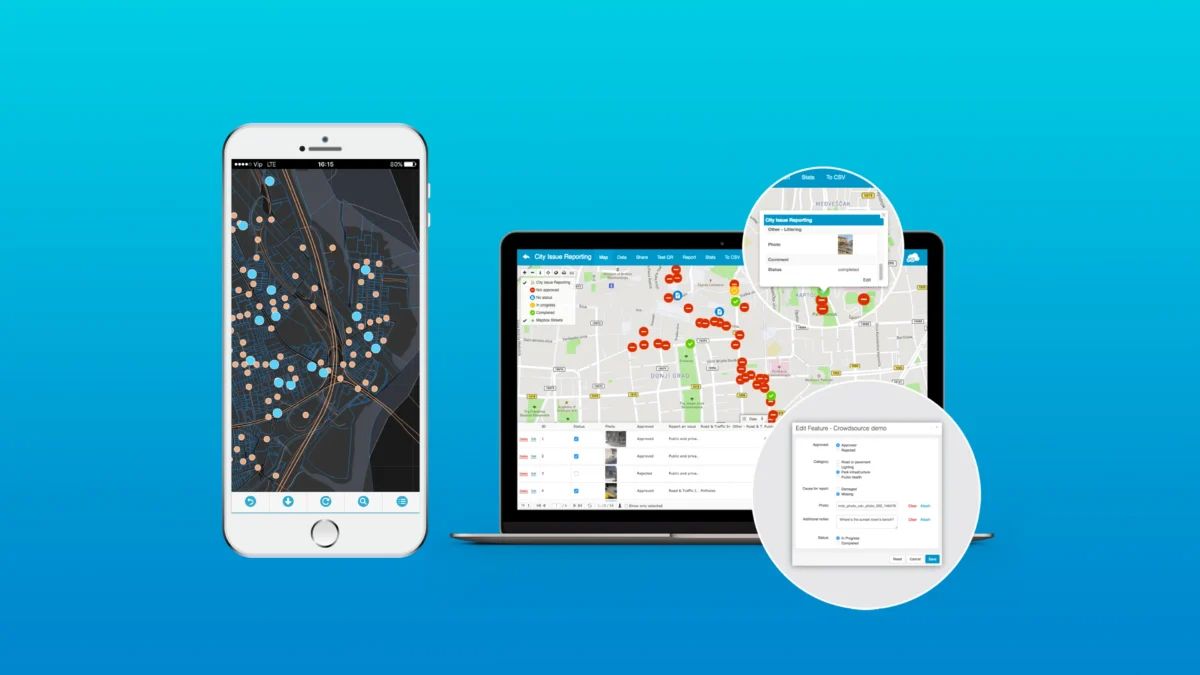
For the integration of GIS and remote sensing, the municipality will create a web-based dashboard for extended functionality. Like ASTERRA, the dashboard will use AI models and processing algorithms to visualize and analyze the data.
Case study: ASTERRA
ASTERRA, an Israeli-based company with U.S. headquarters in California, plays a crucial role in addressing the challenges of drought and water scarcity, issues that are particularly pressing in desert environments like Israel. As highlighted in the article “It’s Getting Hotter and Dryer. Here is What Israeli Tech is Doing About It,” the constant threat of drought, coupled with growing populations and diminishing freshwater supplies, underscores the urgent need for better water management methods. Globally, nearly 17 billion gallons of treated, drinkable water are lost daily due to leaks, a problem that is especially critical in regions where water is already scarce. Water system managers struggle to detect and visualize leaks across vast and complex systems.
ASTERRA tackles this challenge by employing satellite-based synthetic aperture radar (SAR) technology combined with patented, AI-powered algorithms to detect subterranean soil moisture, enabling proactive leak monitoring and infrastructure assessment. This advanced technology offers visual and quantitative insights into soil moisture accumulation below ground, allowing for more efficient water conservation efforts. The radar scans large areas and analyzes expansive systems swiftly, making ASTERRA’s solutions highly effective for water conservation.
As a leader in Earth observation and the water industry, ASTERRA contributes significantly to building drought resilience by identifying areas where water is wasted or where infrastructure needs repair. By using satellites, their AI-driven technology can monitor entire water distribution systems and pinpoint likely leak locations, facilitating faster and more efficient repairs.
ASTERRA’s innovative approach has proven highly effective, helping water program managers achieve their sustainable development goals and increase environmental benefits. The company has identified 60,000 leaks—more than three times the number detected by traditional acoustic methods—saving over 170 billion gallons of water. This positions ASTERRA as a key player in the global effort to mitigate the effects of climate change and ensure sustainable water management.
Benefits
DripDetect is a solution that can be used to meet the following Sustainable Development Goals:
- SDG 06: DripDetect helps reduce real water loss by allowing quick reporting of leaks in potable water systems.
- SDG 09: Support resilient infrastructure by allowing users to assess the integrity of water infrastructure with efficiency to prioritize repair and/or replacement plans and avoid catastrophic failure.
- SDG 11: Contributes to more efficient water resource management within cities, ensuring a more reliable and sustainable water supply. Also enables utilities to assess and manage their pipeline networks proactively, ensuring that cities have robust infrastructure in place to meet the demands of growing urban populations.
- SDG 12: Promote responsible consumption and water-saving methods on social media through posts, infographics, posters, and radio adverts.
- SDG 13: Contributes to the reduction of the amount of potable water lost to leaks as droughts and heatwaves intensify.
- SDG 17: Encourages international partnerships by supporting innovation from international young academics.

Moreover, the app has the following impacts on the community:
This app empowers citizens by providing an easy-to-use platform for reporting water-related issues such as leaks, contamination, or shortages directly to the responsible authorities, bypassing bureaucratic hurdles. Users can track their complaints in real-time, ensuring transparency and accountability from local government or service providers. By facilitating quick responses to water quality emergencies, the app helps reduce health risks and promotes public safety. Aggregated data from user reports enables authorities to make data-driven decisions, prioritizing resources effectively to address critical issues.
The app also enhances community engagement by fostering collective problem-solving. It encourages users to report issues collectively, cultivating a sense of responsibility and collaborative action towards maintaining safe and reliable water infrastructure. Additionally, users can provide feedback on the resolution of their complaints, contributing to continuous service improvement.
On an environmental level, the app supports resource conservation by swiftly identifying leaks and other problems, reducing water waste, and aiding in sustainable water management by highlighting systemic issues that require attention. Local governments and service providers benefit from efficient issue tracking, which streamlines the management of complaints and reduces the time and resources needed for resolution. This responsiveness also helps improve public relations, building trust and credibility with the community.
Finally, the app offers powerful data and analytics capabilities, providing detailed reports on common issues, geographic hotspots, and recurring problems. These insights help authorities make informed decisions and proactive improvements. Historical data from the app can also be used for predictive maintenance, allowing for the anticipation and prevention of future issues, ultimately saving costs and ensuring a reliable water supply.
The Roadmap
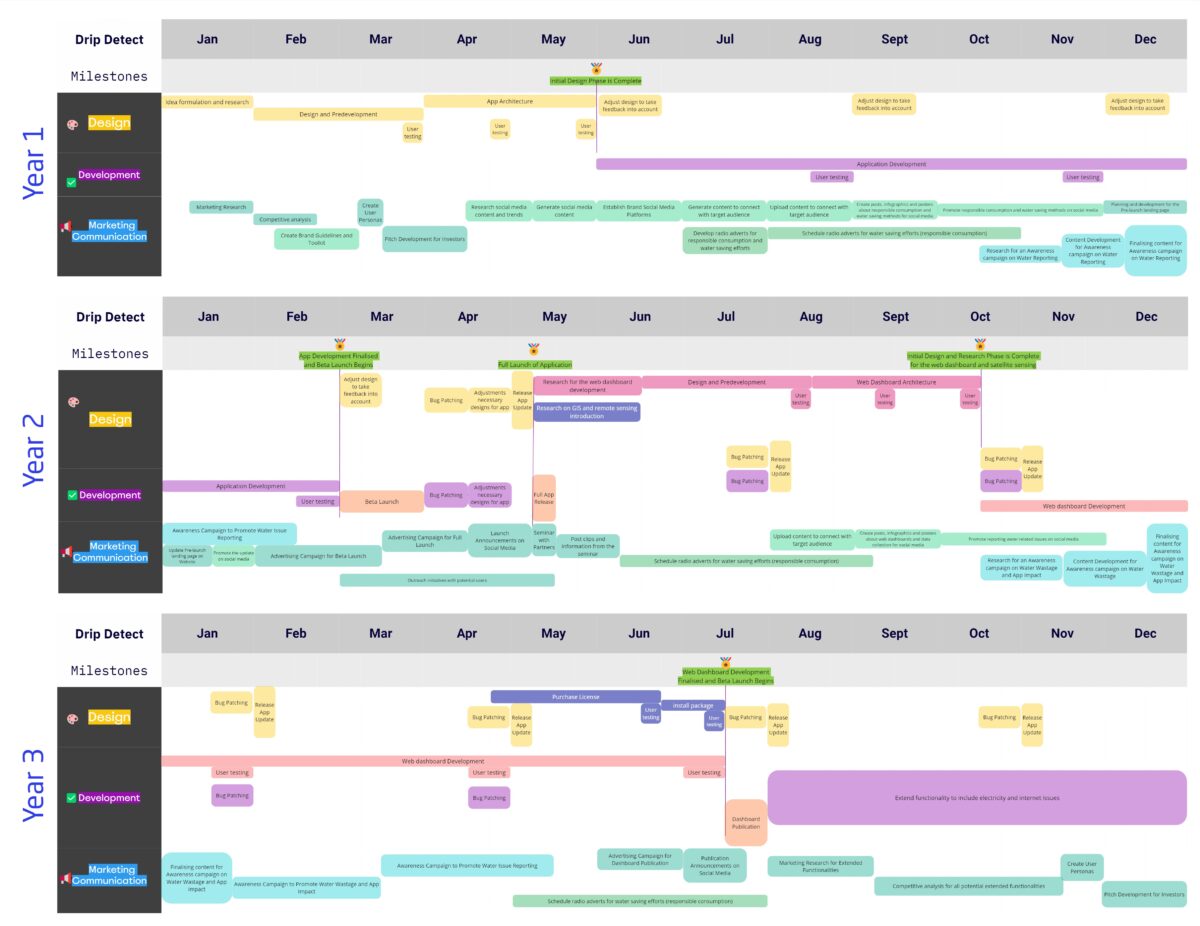
Our roadmap spans over a period of three years. This includes the application’s development, testing, and launching phases and the supporting dashboard. Our roadmap also consists of the layout of marketing communications that will develop alongside the app and dashboard to raise awareness, encourage reporting and usage of the application, and inform the public about responsible water consumption.
In the first year of the roadmap, we have laid out the structure and periods of app research, development, and user testing. The marketing communication in the first year consists of research, development, and content generation for the app and its affiliated social media platforms, as well as the development and running of radio advertising aimed towards responsible water consumption. Towards the end of the year, research and development for an awareness campaign on water reporting and its benefits is set to be created.
The app’s development phase bleeds into the second year of the roadmap, which dedicates time to the final development stages, a beta launch, an app update, and the entire app release. At the start of the second year, our awareness campaign on reporting water issues runs alongside the pre-launch web page, which aims to inform about the beta launch at the beginning of March. The beta launch is then promoted via social media and an advertising campaign to raise further awareness of the application’s existence. Our first year and a half is heavily focused on promoting responsible water consumption and raising awareness for water reporting. This is to ensure that the public is aware of the app and the potential benefits that lead to better water security in the future. After the full app release in May, research begins for the web dashboard and how to introduce GIS and remote sensing. For the rest of the year, the app is scheduled for bug fixes and updates, and social media posts are used to introduce and disseminate information about web dashboards and data collection. This leads to the build-up of the web dashboard development. The last few months for marketing are dedicated to researching and designing content for an awareness campaign on water waste and any impact the app has already had.
The first half of the third year is dedicated to developing the web dashboard, bug fixes, and app updates. The campaign for water wastage and app impact is finalized and launched. A second campaign for water issue reporting is set to run in March, April and May. Radio adverts are also scheduled to promote responsible consumption of water. From the end of April to the middle of July, the licensing and installation of the GIS and remote sensing are scheduled to be incorporated into the dashboard. The dashboard is then published for use. The rest of the year is dedicated to market research and development for newer functionalities or branching applications for reporting electricity and Internet-related issues.
Meet the team

I am Lauren Louw, the team lead of the NextGen Navigators. I am currently doing my BA Honours in Design at Inscape Education Group.
My skill set and competencies include ideation, user experience design, photography, and facilitation of group activities. It is my passion to create relevant and usable solutions for people struggling with a specific issue or problem.

I am Sydney Mandla Khanyile, a Chemical Engineering graduate from the Durban University of Technology (DUT), completing my BEng Tech degree in May 2024. I am enrolled in the BEng Tech Honours program in Chemical Engineering at DUT.
My competencies lie within the use of design software such as Microsoft Visio and Aspen Plus. I am very passionate about research and have strong interpersonal and teamwork skills.

I am Bolelang Tsolo. I am currently doing my MSc in Environmental Sciences at the University of KwaZulu-Natal.
My competencies lie within the use of GIS softwares, Remote Sensing, creating environmental design models, and environmental sustainability.
References
Chaudhary, M. 2024. India’s thirst for improved water security. Available at: https://eastasiaforum.org/2024/02/27/indias-thirst-for-improved-water-security/#:~:text=Nearly%2070%20per%20cent%20of,adversely%20impact%20the%20country’s%20GDP. (Accessed 23 August 2024).
Raman, V. 1983. Significance of losses in water distribution systems in India. Bulletin of the World Health Organization, 61 (5): 867.
Verma, A. 2019. Water Leakage, A Big Issue In Water Distribution And Storage System In India. Available at: https://www.beltecno-global.com/blog/water-leakage-a-big-issue-in-water-distribution-and-storage-system-in-india (Accessed 23 August 2024)
